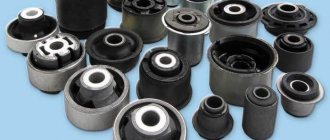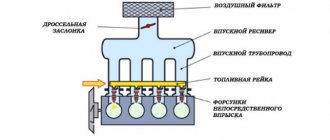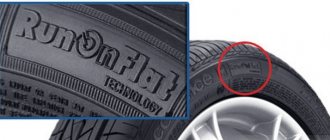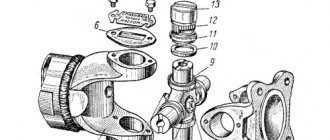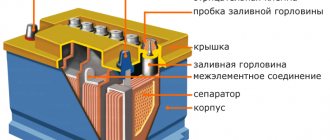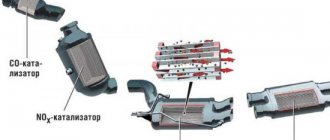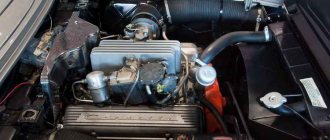What kind of car drive systems exist?
The classical classification implies the existence of three types of drive for a machine. These are front, back and full. But within these types, several more subspecies can be distinguished, which are sometimes worth knowing about when choosing a car. Everything is clear with the front and rear drive options, but the full one raises certain questions, and it is with it that the most difficulties arise when selecting.
So, here are the generally accepted designations for different types of drives:
- FWD (Forward Wheel Drive). This is a traditional front-wheel drive; more than 70% of cars today have exactly this option for transmitting torque to the wheels. The design is classic; in most cases, no subtypes or additional parameters can be distinguished here.
- RWD (Rear Wheel Drive). Under this designation lies traditional rear-wheel drive. The only difference in this torque transmission option is the location of the engine, which determines the design of the transmission. In 99% of cases, the engine is installed in the front, and the torque is transmitted through the driveshaft. But there is also a rear engine location.
- 4WD (Four Wheel Drive). This is a classic all-wheel drive, which can be permanent or plug-in. Previously, these types of technologies could be easily recognized by two levers in the central tunnel. The main difference is the mechanical differential lock, so that it is possible to transmit torque equally to all wheels at once.
- AWD (All Wheel Drive). This is a modern, adapted version of all-wheel drive, where the electronics decide which wheels to connect to the engine at a particular moment in time. Complex electronics and rather poor efficiency were disadvantages of the first AWD cars, but today everything is actively changing.
The last two types of all-wheel drive can also be divided into two more groups. The first will include cars with main rear-wheel drive and a front axle connection. And the second group will initially include front-wheel drive cars with a plug-in rear axle.
All about all-wheel drive. Part one: history, types, features, differences
When did all-wheel drive appear? What types of it do we know? What are the principles and mechanisms of its operation? What are the main differences? What are the pros and cons of different designs? Which one is the most common? How is four-wheel drive implemented in hybrids and electric vehicles? About all this - and more! - in today's material Droma.
A brief excursion into history
The history of the creation of all-wheel drive vehicles began at the end of the 19th century, and we simply must, to complete the picture, identify some key models in this direction. But we will deliberately omit everything related to trucks - we are still much more interested and closer to passenger cars. And also, in the historical part, we will not touch upon the simplest type of all-wheel drive - part-time with a hard connection, because there is nothing special to tell here: the most unpretentious and reliable, in our time it is used only on pickup trucks and real SUVs.
Lohner-Porsche (top), Spyker 60HP Racer, Miller 91 and Bugatti Type 53 (bottom)
In 1899, the great Ferdinand Porsche came up with the idea of not only building a petrol-electric (!) Lohner-Porsche hybrid, but also equipping each wheel with a separate electric motor. At an exhibition in Paris in 1900, this miracle was presented to the public. Three years later, brothers Jakob and Henrik-Jan Spyker from Holland demonstrated the first car with a 4x4 wheel arrangement and even three (!) differentials, but without any electrical component - Spyker 60HP Racer. By the way, it was also the first in the world with an inline 6-cylinder engine. As you know, in 1929, the first car with front-wheel drive appeared - the Cord L-29 - designed by Frederick Duesenberg and Harry Miller. The latter, in collaboration with the FWD (Four Wheel Drive) company, created the Miller 91 racing car with an 8-cylinder 300-horsepower engine in the early 30s. A little later, Bugatti followed his example, creating, on the initiative of Fiat engineer Antonio Pichetto, an all-wheel drive and also 300-horsepower Type 53.
A little theory, or Why do you need all-wheel drive and what is “lowering”?
For what?
Why did the task of driving all four wheels of a passenger car arise? Firstly, all-wheel drive allows you to use the power of the power plant much more efficiently - with a larger actual tire contact patch and less slippage. Secondly, an important factor has always been improving the cross-country ability of off-road vehicles. Thirdly, the 4WD drive provides greater vehicle stability when cornering, especially on slippery surfaces, and, as a result, a high level of safety. And fourthly, all-wheel drive gives the driver another control tool, in addition to the traditional steering wheel and pedals: by varying the level of torque on the axles, you can change the character of the car - from one prone to understeer to, on the contrary, rear-wheel drive. Negative factors are considered to be excess weight, design complexity and increased fuel consumption.
How does it work?
A differential is always installed on the drive axle of the car, which transmits more torque to the wheel that has less resistance and, as a result, traction. On single-wheel drive vehicles with “free” (without the possibility of locking) “diffs”, only one wheel will always slip. The all-wheel drive system allows, using various methods (which we will discuss below), to transfer part (or all) of the torque to the wheels of another axle, which, even with another center differential, makes “hitch” much more likely. Consequently, the vehicle's behavior on slippery surfaces and off-road conditions improves. Self-blocks (blocking “diffs”) are mechanical, hydraulic and electronic; with varying degrees of blocking, up to 100%. The all-wheel drive design of SUVs often also uses a reduction range of transmission, which, accordingly, ultimately allows more torque to be delivered to the wheels at the same engine speed.
The next milestone in the history of all-wheel drive is, of course, the creation of a car with a self-locking center differential, which would allow the torque to be automatically transferred to the axle that has better traction. The introduction of this topic is directly related to the names of two Englishmen - Tony Rolt and Fred Dixon. In 1950, after creating the all-wheel drive “Crab” concept, they moved to the company of the famous tractor magnate Harry Ferguson, and former Aston Martin designer Claude Hill was invited to help them. In 1956, they created the first prototype - the Ferguson R4 - which was simply replete with technical innovations: all-wheel drive, a flat-four, disc brakes and even an electromechanical single-channel Dunlop MaxaRet ABS from... the aircraft industry. An additional set of gears, two overrunning clutches and two clutch packs were installed inside the torque converter with the transfer case, which could block the “center” if one of the axles slipped. The next prototype was the station wagon (!) R5, built in 1962, but it never came to production. True, the designers managed to interest the Jensen company, together with which they first built the experimental coupe CV8 FF (Formula Ferguson is a patented name), and in 1966 the famous Jensen FF appeared - the world's first car with a self-locking center diff and ABS. But only 318 super-expensive cars were produced. Tony Rolt did not rest on this and, together with Derek Gardner (later the designer of Tyrrell), they later went down in history as the inventors of the viscous coupling - a device with a much smoother and more understandable locking.
Ferguson R4, Ferguson R5 and Jensen FF
The first car with a cross-axle differential locked by a viscous coupling was the American AMC Eagle in 1979. Well, then off we go. Audi's quattro all-wheel drive, by the way, was equipped with mechanical locking until 1984, and after that with a Torsen "diff", which changed the degree of locking in response to changes in torque on the output shafts, and did not need a viscous coupling. In 1985, a number of other companies presented their vision of an all-wheel drive system. There were 4MATIC from Mercedes-Benz, the first X's from BMW, Syncro models from Volkswagen... Already in the 90s, cars were “overgrown” with electronics, which made it possible to control torque on different axles and wheels using ABS sensors, the first systems with so-called active cross-axle differentials. We will go into more detail about the specific features of each “branded” system in the second part of our story about all-wheel drive, which will be released a little later. Look forward to Drome soon!
AMC Eagle Wagon, Audi Sport quattro and Volkswagen Transporter T3 SyncroWell, for now we will tell you about the features and differences, pros and cons of the main all-wheel drive schemes currently used. And let's start, of course, with the most “ancient” and simplest one - the so-called part-time with a rigid connection of the front axle.
Types of all-wheel drive and their features. Advantages and disadvantages
Part-time 4WD
Hard-wired all-wheel drive
The simplest and most reliable all-wheel drive system is considered to be hard-wired 4WD, or part-time. Due to its simplicity and utilitarian nature, this version is most often found on trucks, utilitarian SUVs or pickups. Currently, it is truly an endangered species.
Already from the name it is clear that when the all-wheel drive mode is turned on, both axles of the car are connected directly, without a differential, through the transfer case, distributing torque in a constant proportion of 50:50. In fact, part-time is only suitable for temporary connection in off-road or slippery conditions: only in this case is it possible for one of the axles to slip to compensate for the lack of inter-axle “diff”, which allows the wheels to rotate at different speeds. It is for this reason that part-time all-wheel drive is not recommended for use on asphalt and at high speeds. Most cars with this type of transmission have a maximum speed limit of 80–100 km/h in 4WD mode.
Examples of car models: Toyota Hilux, UAZ, Jeep Wrangler, Nissan Patrol (until 2010), Suzuki Jimny.
Toyota Hilux, Jeep Wrangler and Suzuki JimnyPros and cons of part-time:
minus>
| Simplicity, reliability | Restrictions on using all-wheel drive on stable hard surfaces | |
| Disabling 4WD to save fuel and improve handling | Damage to the system caused by improper use | |
| Poor handling in 4WD mode due to lack of differential | ||
| Large weight, cardan drives | ||
Full-time 4WD
Permanent all-wheel drive
If the car has permanent all-wheel drive, then there is no way to make it single-wheel drive. After all, there is already a central differential between the axles, and torque always comes to all four wheels, although in different proportions.
Without the ability to lock, such a system would make no sense, since the differentials (first the center differential, and then the cross-axle) would simply direct all the torque to the slipping wheel. Therefore, in the design of transmissions of this type, one or another locking mechanism is used. It can be implemented in different ways. For example, on SUVs there is often a 4WD Lock (or similar) “hard” locking mode, which distributes torque in a 50:50 ratio, essentially turning the scheme into part-time. On crossovers and passenger cars, various types of devices are used - viscous, electro-hydraulic and electromechanical clutches, various types of self-locking differentials - which can distribute torque in fairly wide ranges (up to 100%) and at the same time be locked electronically. The “floating” moment allows the all-wheel drive vehicle to be controlled adequately on all types of surfaces, to hold better in turns and use 4WD at any speed.
Examples of car models: Toyota RAV4 (I & II Gen), Subaru VTD, VW Touareg, Land Rover Discovery, Toyota Land Cruiser (since 80).
Toyota RAV4, Land Rover Discovery and Toyota Land CruiserPros and cons of full-time:
minus>
| Relative simplicity, reliability | Mandatory presence of some type of central differential lock | |
| No restrictions on using 4WD mode | Increased fuel consumption | |
| Less weight compared to part-time systems | ||
Selective 4WD
Switchable all-wheel drive
The essence of selective drive is to combine the advantages of the two 4WD systems that we discussed above: part-time and full-time. Another feature is the ability to disable the front-wheel drive, rather than connect it. Thus, cars equipped with these types of systems are initially all-wheel drive, but can only be driven in rear-wheel drive to save fuel. At the same time, the all-wheel drive mode has no restrictions on the type of surface and speed. At the same time, they all have the ability to rigidly lock between the axles, which suggests the main area of use - on full-fledged SUVs and pickups, for example, Mitsubishi Pajero or L200, Toyota Sequoia, Jeep Grand Cherokee and Nissan Pathfinder. Often, such cars are also equipped with a rear axle lock.
Types of such systems: Mitsubishi SuperSelect, Toyota Multi-Mode, Renault/Nissan All-Mode 4×4, Jeep SelecTrac.
Mitsubishi Pajero, Toyota Sequoia and Jeep Grand CherokeePros and cons of Selective AWD:
minus>
| Possibility to “detach” one of the axles to save fuel | Quite a complex architecture | |
| No restrictions on type of coverage and speed in 4WD mode | ||
Automatic AWD, or TOD (Torque-On-Demand)
Automatic all-wheel drive
Finally, we got to the systems that now have total superiority on the market. From the name Torque-on-Demand (torque on demand), it becomes clear that in normal driving modes such a car is... single-wheel drive. If the engine is located transversely, then it is initially front-wheel drive, and if it is longitudinally located, then it is rear-wheel drive. If wheels slip on the drive axle, torque is transferred to the other (most often through a viscous or electronically controlled friction clutch). As a rule, on this kind of car - after all, they are mostly “city slickers” - there are no center locks, but sometimes there is the possibility of both “locking” the center (50:50) and forcibly disabling all-wheel drive. Automatic AWD is the lightest and most common all-wheel drive system, abundantly “hung” with various kinds of electronics to control a wide variety of vehicle parameters and systems.
Examples of car models: Subaru Active AWD, Toyota RAV4, KIA Sportage, Volkswagen Tiguan, Hyundai Creta.
Volkswagen Tiguan, Toyota RAV4 and KIA SportagePros and cons of Automatic AWD:
minus>
| Fuel economy even in automatic mode at low loads | Possible overheating of the clutch in off-road conditions | |
| Fully automatic all-wheel drive mode | A large number of electronics | |
| Light weight | Poor maintainability | |
| Can be used on almost all vehicles | ||
AWD with active or (self-)locking differentials on the axles
The main difference between this type of system is the possibility of blocking (full or partial) cross-axle differentials, as well as electronic control of the speed of rotation of the wheels of one axle. Hard locks are needed in bridges to significantly improve cross-country ability in severe off-road conditions. It is not without reason that such a scheme (with three locks) was used for a long time on the Mercedes-Benz G-Class (until the latest generation), and off-road tuners often equip jeeps with locks that do not have such an option from the factory. It must be remembered that the presence of locks requires strengthening of axles or drives, as well as very careful use off-road.
The Subaru WRX STI is currently the only passenger (not SUV) production car in the world with three locks. But its story is different: this was done to improve handling, grip in corners and better torque delivery on slippery surfaces.
An active electronically controlled “diff” in various forms is installed (usually on the rear axle) for the same purpose - to allow the driver to control the car not only with the gas and steering wheel, but also by increasing the torque or rotation speed of the outer wheel, thereby turning the car into a turn. The most prominent representatives of this kind of systems are Mitsubishi Evo, Honda and Acura with the SH-AWD scheme, BMW sports models and others.
Examples of car models: Mercedes-Benz G-Class, Jeep Wrangler Rubicon, Subaru WRX STI, Acura MDX, Nissan GTR.
Mercedes-Benz G500, Acura MDX and Subaru WRX STIPros and cons of active differentials:
minus>
| More interesting handling | Complexity and high cost of the system | |
| Possibility to reduce turning radius | Frequent breakdowns | |
| Best performance on slippery surfaces | ||
Hybrid & Electro AWD
All-wheel drive hybrids and electric vehicles
Nowadays, more and more cars are equipped with hybrid or even all-electric powertrains. In the simplest and most inexpensive cases, the drive most often falls on one of the axles, but there are also all-wheel drive options in expensive and “premium” segments. The most famous hybrids with 4WD drive are perhaps Lexus crossovers and sedans, the rear axle of which is driven by a less powerful separate electric motor, and electric mileage is minimal. There are also options when the electric motor is located between the internal combustion engine and the transmission: Porsche e-Hybrid, Volkswagen GTE, Mercedes-Benz S500e...
In electric vehicles, things are even more complicated. As you understand, to implement the very idea of an all-wheel drive electric car, it is necessary to have at least two electric motors - one for each axle. According to this scheme, for example, the production Tesla Model S was built. But modern manufacturers of electric supercars go further, installing three (Audi e-tron S) or even four (Lotus Evija) motors - one for each wheel in the latter case. Naturally, electric vehicles do not have any differentials or “locks”; all control over the implementation of all-wheel drive is entrusted to the electronics.
Examples of all-wheel drive hybrids: Lexus RX. Examples of all-wheel drive electric vehicles: Audi e-tron S, Tesla Model X, Lotus Evija.
Lexus RX, Tesla Model S and Lotus EvijaPros and cons of hybrid and electric all-wheel drive:
minus>
| High torque and power | Complexity and high cost of technology | |
| Saving or complete independence from fuel | Large mass | |
| Possibility of flexible configuration using electronics | Fully electronic all-wheel drive with all the ensuing consequences | |
We hope that this material was useful and interesting for you, and in the second part we will tell you about the most famous all-wheel drive systems used on modern cars, crossovers and SUVs - 4MATIC, quattro, xDrive, ATESSA, SH-AWD, S-AWC and others. Very soon on Drome!
Read more about what AWD is
Let's take a closer look at the information about AWD - what it is in a car and how to use it. This type of drive system is most often installed on crossovers. They are also used by manufacturers of sedans and station wagons with off-road capabilities. In this case, you will not be able to make the car go with all-wheel drive exactly when you want it. The electronics decide when to connect the rear axle.
Some features of the AWD system:
- in most situations, the front axle will be the main one, the rear axle is connected if necessary;
- there is no forced inclusion, except perhaps software and electronic configuration methods;
- there is no forced differential lock, there can only be electronic imitation;
- the effectiveness of this type of drive is controversial; very often the connection of the rear axle turns out to be untimely;
- the quality of service depends very much on the manufacturer; only an expensive set of sensors solves many issues.
Fans of real jeeps do not accept AWD, considering it insufficiently efficient and weak. But it all depends on the driver’s skills, understanding of his car, as well as the scope of operation of the car. Therefore, it is not worth saying right away that such a drive is bad. You need to study the features of its operation and purpose so as not to expect something unclear from the vehicle.
Recommendations for driving a car with all-wheel drive
To drive a four-wheel drive car successfully, you should follow a number of recommendations. For each type of all-wheel drive, the recommendations are slightly different.
How to drive a car with multi-mode drive . With multi-mode drive, there are many ways to connect the drive wheels. The choice of these options depends on climatic conditions and the quality of the road surface.
In light off-road conditions, use automatic mode . On slippery roads you need to switch to permanent all-wheel drive mode. When driving on dry asphalt, it is recommended to use one drive axle - this will minimize fuel consumption. In complete off-road conditions, you should use a lower gear, while locking the differential.
How to drive a car with permanent drive . When driving with permanent drive, it is important to use a center differential lock. If you need to overcome a section of road with a long slippery slope or a thick layer of snow, sand, or mud, it is recommended to engage the differential lock in advance.
How to drive a self-driving vehicle . Driving a car with this type of drive will not be difficult. All-wheel drive will be engaged automatically when overcoming a difficult section of the road (off-road, climbing a slippery road).
How to drive a car with plug-in drive . It is recommended to use all-wheel drive only when driving on off-road or slippery asphalt. If the road surface is hard and dry, you should turn on the drive on one axle.
What are the differences between the different types of all-wheel drive technologies?
A logical question when purchasing modern crossovers and SUVs is what is the difference between AWD and 4WD. In fact, the differences are that in the 4WD system you yourself can control the processes of transmitting torque to the wheels, and in the crossover adapted version the electronics do everything for you. Fewer and fewer cars get the classic 4WD option, giving way to more expensive and technologically advanced systems.
As a rule, in cars with 4WD the front axle is disabled, and the rear axle is permanently connected to the transmission system. In AWD the opposite happens. Mechanical locking, adjustments and control capabilities of the drive system are an exclusive privilege of real 4WD jeeps.
Classic technology uses a transfer case, which has many functions, but in modern cars, all the work is done by an electronic control system with many automatic functions. As you can see, the difference between 4WD and AWD is quite significant.
Are there clear advantages to AWD technologies?
When comparing 4WD or AWD, we can highlight some disadvantages in all technologies. But for now we will try to focus on the benefits. There are many benefits to each all-wheel drive technology if you take advantage of them. For example, a trip around the city in the summer will not demonstrate any advantage of such technology.
But you will get the following advantages in a car with AWD:
- more confident operation of the car on the highway, significantly increased directional stability;
- a confident ride in difficult conditions, which allows you to get out of any trouble without help;
- the ability to move off the asphalt onto moderate off-road conditions when traveling to nature or fishing;
- you don’t need to configure anything, the electronics will perform all the assigned tasks for you without any problems;
- To save fuel, the system will automatically disable all-wheel drive when it is not necessary.
As you can see, this technology has many advantages. Of course, we are talking about AWD in isolation, without comparing the system with other all-wheel drive technology options. However, cars with such options have quite a lot of obvious visible advantages. So under certain conditions, paying extra for all-wheel drive will really be worth the money.
Advantages and disadvantages
Having all-wheel drive has its advantages and, of course, disadvantages. The main advantages of such a car are:
- high safety and increased stability of the machine on different surfaces;
- increased cross-country ability;
- improved driving dynamics, use of the power plant more efficiently;
- agility and quick start without delay or slipping are common for cars with the 4x4 formula.
The disadvantages include the following:
- complex design;
- increased fuel consumption;
- high metal consumption of the transmission itself;
- In addition, an all-wheel drive car is more expensive in price compared to a single-wheel drive car. Accordingly, car repairs are more expensive due to the complex design.
What are the disadvantages of an AWD drive system?
- Electronics. It all depends on a whole bunch of sensors that can fail at any moment and not turn on the drive or turn it off at the right time.
- No manual settings. For many car buyers, this will be a real problem; you cannot configure anything yourself.
- Incomprehensible moment of turning on the drive. Skidding and other unpleasant situations are quite possible if you do not feel the moment when all-wheel drive is engaged.
- Expensive repairs. AWD systems are incredibly difficult to repair because they are a collection of expensive electronic systems and sensors that are difficult to diagnose.
- High expectations. Often the buyer of a car with AWD believes that he has a real SUV, but more often than not these cars do not live up to such expectations.
- Overpay if you don't need all-wheel drive. Statistics show that more than half of all-wheel drive cars are bought for image rather than for real use.
Results and some thoughts about all-wheel drive
In Russia there is a cult of all-wheel drive vehicles, which stems from rather difficult road conditions. But today the roads in the Russian Federation are no longer so terrible; public utilities clean them well. You need all-wheel drive if you live in a village, go hunting or fishing every day, or constantly travel in difficult conditions. Also, in the northern part of the country, jeeps with a truly brutal character are often needed in order not to freeze in a snowdrift. But in other cases, an all-wheel drive car often ends up being wasted money at the showroom.
Consider whether you need all-wheel drive at all. If you decide that it is impossible to live without this option, try to find a car with 4WD. Most often, these are not very beautiful SUVs whose task is to overcome difficulties.
There won't be too much comfort in them either. But cars with AWD serve to slightly increase comfort compared to conventional front-wheel drive versions of those same cars. This is far from an SUV that will not please you with its confident cross-country ability.
Not all motorists know what AWD is and what its purpose is in a car. The situation is clarified by decoding the abbreviation AWD: translated from English “All whell drive” this means “all-wheel drive”. Many find it difficult to answer what the key features of this modern technology are. This is exactly what will be discussed in this material, which has not only purely informational, but also practical significance for many of our readers.
What is permanent and plug-in all-wheel drive?
All-wheel drive is classified into four groups: plug-in, permanent, automatic, multi-mode. Each type of all-wheel drive has several features.
Connectable (Part time) . This type of drive is used on Kia Sportage cars (manufactured before 2002), Ssangyong Kyron, Suzuki Jimny, UAZ. Its main task is to reduce fuel consumption when driving on good road surfaces.
Part time is activated using an additional button or lever. It does not use a center differential. Therefore, in order to avoid accelerated wear of transmission elements and tires, increased fuel consumption, and deterioration of controllability when cornering, it is recommended not to drive the Part time drive all the time.
Permanent (Full-time) . Installed on cars of a number of well-known brands: Toyota Land Cruiser, Mercedes ML, Lada Niva, Daihatsu Terios. It has interaxle and interwheel differentials. Ideal for driving on hard road surfaces.
Automatic (Automatic or On demand) . Used on Nissan Quashqai, Mitsubishi Outlander XL, Honda CRV, Chevrolet Captiva. It turns on automatically if the drive wheels slip.
Multimode (Selectable) . Used in Jeep Grand Cherookee and Mitsubishi Pajero cars. Has no disadvantages. It has absorbed the advantages characteristic of other types of all-wheel drive. Allows the driver, at his discretion, to drive on two drive axles or only one.
What kind of car drive systems exist?
First, it’s worth figuring out what the main difference between this technology and other similar technologies associated with car drive systems is. In particular, what is the difference between AWD and 4WD technology is also a very common question. Finally, what are the advantages that make drivers adopt it?
Considering the essence of technical innovation, AWD is, by and large, an automatic system that operates independently of the drivers. And this is one of its main specific features. To understand this, you need to understand exactly how it works.
Read more about what AWD is
So, let's look at AWD technology, namely what it is in practice in a modern car, and get acquainted with the term “all-wheel drive.” The idea behind this technology itself is ingenious:
- As you know, the drive system in each wheel is equipped with many sensors. Their task is to measure the angular velocity of rotation and other important parameters.
- All this information in the car is transmitted to the computer. It is deciphered there.
- The computer analyzes the resulting mass of data in accordance with its program. And depending on how each wheel behaves, it makes the optimal distribution of power and torque. And not only along the axles, but also separately along the wheels. Needless to say, what this means for the car, how convenient and important it is for it.
This, in short, is how the operation of AWD technology is fundamentally different from 4WD and other drive systems on cars. It is not for nothing that the abbreviation AWD is deliberately interpreted by many in the first word “All” as “Automatic”, that is, “automation”. That is why the system is now installed on almost a third of powerful modern crossovers, as well as on many pickup trucks. The list of such advanced cars is huge: from Acura and Honda to Nissan, Audi and Toyota
Are there any clear advantages to AWD technologies?
To illustrate the key clear advantage of AWD technology over other similar drive formats in a car, let’s imagine driving on an ordinary domestic road, not ideal, but not broken into pieces. It is clear that for such a road there is no need to use front-wheel drive, since this will only lead to increased fuel consumption. You can completely get by with a drive on two front wheels: this will give not only savings, but also good controllability of the car.
But here is a completely different picture. So, you found yourself on a terrible dirt road, especially after the rain, and it turned into a continuous mess. If you use two driving wheels, you won’t go far, since there is a high probability of completely “dropping anchor” in some unnoticed hole full of slurry.
Therefore, the AWD system automatically connects both rear wheels to work using the on-board computer. Part of the engine power is transferred to them. In other words, the car becomes all-wheel drive.
As for the difference with the 4WD format, with its help the power is distributed equally between the wheels and axles. In our case, the front axle practically receives the main load, taking up more than 60% and up to 90% of the power and torque. Only certain car brands (for example, Audi) distribute them equally, in a ratio of 50 to 50. If you buy a car, the last point must be taken into account.
Part-time
This guy appeared first. It represents a diagram of the hard connection of the front axle. That is, the front and rear wheels always spin at the same speed. There is no center differential.
A differential is a mechanical device that takes torque from the drive shaft and distributes it proportionally between the drive wheels, automatically compensating for the difference in their rotation speed. We can say that a differential directs torque to the drive wheels, allowing them to rotate at different/differentiated angular speeds (hence the name itself - differential).
Differentials are located in the front and rear axles on all vehicles equipped with all-wheel drive. On some cars, a differential is also used in the transfer case (this all-wheel drive scheme is called full-time, we will talk about it a little later).
Let's try to figure out why a differential is needed. The wheels of any car rotate at the same speed only when the car is traveling straight. As soon as it starts turning, each of the wheels begins to live its own life. One of the wheels of each bridge begins to spin faster than the other, and the bridges themselves compete with each other in speed. This happens due to the fact that the wheels follow different trajectories. The one on the outside of the turn travels a longer distance than the one on the inside. So are bridges. Accordingly, the inner wheel (or the axle to which it belongs), if not for the differential, would simply rotate in place, compensating for the movement of the outer wheel.
It is clear that in this case we cannot talk about any driving at high speeds. The lack of controllability will not allow this, and the load on the transmission will quickly damage it, not to mention prematurely worn out tires. The differential is what allows one axle to overtake the other when there is a difference in their speeds.
Part-time does not have a center differential, torque is transmitted equally to the axles, rotation of the axles at different speeds is impossible, so driving with the front end connected is highly not recommended. With a short straight motion, even in a low gear, nothing bad will happen (you can pull the cart with the boat out of the lake). But when you try to make a turn, the same difference in the lengths of the bridge paths arises. We remember that the torque is transmitted equally - 50/50, and there is only one way out of its excess: slipping of the wheels of the front or rear axle on one of them.
In mud, sand or gravel, nothing prevents the wheels from slipping if necessary due to the weak grip of the wheels on the ground. But on asphalt in dry weather, the output of this power is realized in exactly the same way, which entails increased load on the transmission, rapid wear of rubber, deterioration of controllability and directional stability at high speeds.
If the car is needed mainly for off-road use, and there are no plans to use all-wheel drive on asphalt, part-time is quite justified, since one of the axles is immediately connected rigidly, and there is no need to block anything. And the design is simpler and more reliable: there is no differential or locks, no mechanical or electrical drives to these locks, no unnecessary pneumatics or hydraulics.
But if you just want to calmly ride on the asphalt in any bad weather and not worry about alternating icy and clean asphalt sections, snow drifts, water-filled stripes or any other slippery-loose-unpleasant areas, part-time is not the best option: if you drive with the front axle always on, this threatens damage or wear; turning the axle on and off is not very convenient, and you may not have time to turn it on.
Cars with this type of all-wheel drive: Toyota Land Cruiser 70, Nissan Patrol, Nissan Navara, Ford Ranger, Mazda BT-50, Nissan NP300, Suzuki Vitara, Suzuki Jimni, Great Wall Hover, Jeep Wrangler, UAZ.
